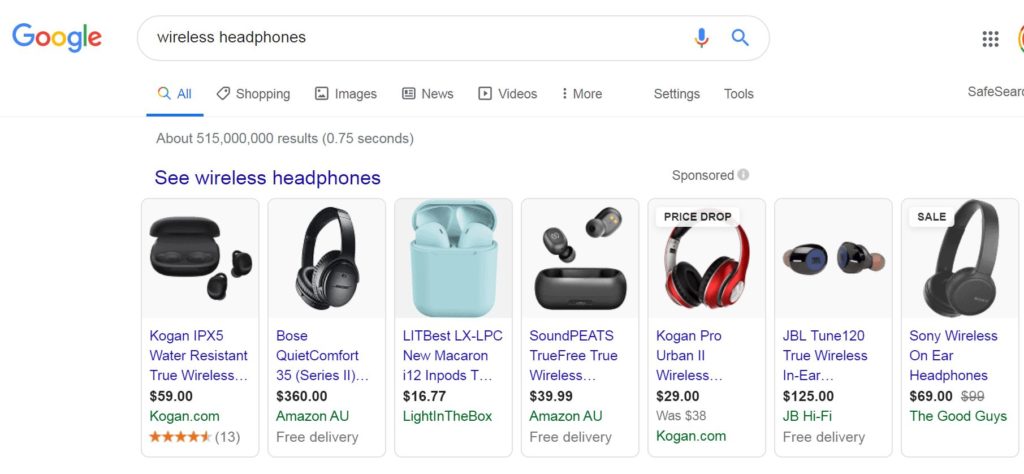
What are the Benefits of eCommerce SEO?
You don’t want to have to pay for every customer that walks into your store, so why should you pay for every customer that opens your online store?
Google ads and social media advertising are definitely great methods to generate sales from an online website, but harnessing the power of organic SEO allows you to snatch up the extra money on the table from people searching the internet to buy products.
SEO, or Search Engine Optimisation, is the process of generating more website traffic from organic sources, i.e. not paid advertising. The ultimate goal of SEO for eCommerce is to get your product page as the first natural result on the first page of Google.
This guide gives you six of our most important steps in optimising SEO for increasing the sales from your website:
1. Keyword Research
The first step for any SEO strategy is always keyword research.
Without doing this part, you won’t know which keywords to optimise for, and all your effort will be for nothing.
A great place to start your keyword research is with the Google Keyword Planner – a free tool offered by Google Ads. At at+m marketing, we use a suite of premium SEO tools with more features, enabling us to compare and contrast your website’s keywords with your competitors’, but the Google Keyword Planner does often serve as a solid foundation for our SEO research.
Whichever tool you end up using, you should look for keywords with high traffic and low competition. High traffic means that these keywords are hit with a large number of regular searches, and keyword competitiveness refers to how difficult it is to rank for that keyword. For example, no matter how many times you include “Amazon” on your website, it’s pretty unlikely you are ever going to rank higher than the king of eCommerce.
2. Optimising Product Descriptions
Managing SEO for an eCommerce website can be very different than with other sites. Typically, keywords can be used throughout long-form content to get search engines to notice a website, but with eCommerce, there isn’t as much opportunity. Small product descriptions serve as the main content on the page, so you have to get pretty crafty to get the right mix of keywords and content that is easy to read.
Refer back to the list of keywords you put together during the last step. Think about the search terms your customers might be using to find specific products and work them in to your product descriptions.

Product descriptions need to be clear, informative, and tailored for SEO.
Optimising product descriptions is the low-hanging fruit when it comes to eCommerce SEO. If you already know which keywords to use, product descriptions should be relatively simple to write. Just keep them clear and simple, making sure to describe the product with the correct keywords.
Not only do these descriptions help to sell the product to potential buyers, they also act as a silent salesman, communicating quietly with Google to get your products ranking on search pages.
3. Page Titles and Meta-Descriptions
Page titles and Meta-Descriptions are the pieces of content from your website that people read on Google results pages. See in the image below, the page title is shown in red, while the meta-description is shown in blue.

Page titles and meta-descriptions are an oft-overlooked SEO strategy which contribute significantly to the ranking and CTR (click-through rate) of your website.
Page titles contribute greatly to the keyword ranking of your site, with keywords in the title assigned higher weighting than other content. Meta-descriptions on the other hand, do not contribute keywords, and Google has stated that they do not directly affect page ranking, but that doesn’t mean they aren’t useful.
Optimising your website’s meta-descriptions leads to a better, and more informative user experience on the Google results page. If you don’t set meta-descriptions manually, then Google automatically creates them from content on the web page, which can end up looking pretty ugly…

Optimised page titles and meta-descriptions lead to Google results which may rank higher for your chosen keywords, and which give potential customers more reason to click through to your website.
4. Site Security and SSL Certificates
While many of the methods Google uses to rank websites are kept under lock & key to avoid dodgy SEO practices, it’s no secret that Google prefers websites which are secure and don’t divulge user’s private data. Your customers will probably appreciate it too.

You might have seen one of these ‘your connection is not private’ messages when you’ve tried to visit a website, and it probably made you feel like taping over your webcam, right? While these notices don’t really mean that a hacker is watching your every move, they are a sign that the website you are trying to visit doesn’t have an SSL (Secure-Socket Layer) certificate, which is a small data file that allow a secure, encrypted connection between the user and the server of a website.
SSL certificates are the difference between http:// and https://.

These messages on their own are enough to stop customers from shopping on your site, but not having an SSL certificate also means that Google will shun your site. SSL certificates are included with any competent web designer’s hosting & security package, so this decision is a no-brainer.
5. Site Structure
Your website needs a clear, understandable site structure which places related pages with each other, and has menus that are easy to use on all platforms.
For users of your site, the structure has a significant impact on the way they browse different pages and find information. Menus need to be accessible, and no page should be more than 2-3 clicks away from the home page. If someone comes onto your website looking to purchase your products, but has to go through 5 different unrelated pages to get to the shop, they will probably go somewhere else.
As well as impacting the user experience on site, site structure also has a considerable effect on SEO; for three main reasons:
- It improves Google’s ability to interpret your website
The way your site is structured gives a baseline for Google to understand what your products are, and where the most important content is on your site. In this regard, a good structure allows Google to index content more efficiently, which could in turn lead to a higher ranking in Google results. - It stops pages on your site from competing with each other
If your website is all about your brand and your content, then there is likely to be some similar content and keywords spread around. Without a good site structure, Google won’t know which of these pages to prioritise, and you may end up competing with your own website in the search results. A good internal linking structure, along with the use of more advanced methods such as canonical tags, will help to prevent this from happening. - It ensures consistency over time
It’s not likely that the content and products sold on your website are going to stay exactly the same over time, and if your site structure depends on individual pages rather than categories, everything can go haywire. Having a good site structure makes it simple to introduce new products and delete old ones. Without it, Google may show users outdated products rather than their current versions, which leads to disappointed customers and less sales for your business.
6. Schema Markup and Rich Snippets
This is where it gets a bit more complicated…
Excusing the jargon, Schema markup is an SEO method of using bits of code known as structured data to optimise the display of website listings, otherwise known as rich snippets in Google results. To put it more simply, it is a way to tell Google what kind of content is on the page it is displaying, which it can then use to optimise the way it is shown to users.
The use of rich snippets creates an improved user experience, where users get more information, which is more relevant to the web page it refers to.
One common use of rich snippets is for online recipes, which often show the cooking time and number of calories in the completed recipe.

In addition to their use for telling hungry Googlers the number of calories in a slice of chocolate cake, Schema markup can also be used to significantly optimise the display of eCommerce results in Google searches.

It’s a no-brainer that your products being shown at the top of the search page in a dedicated eCommerce slider can increase customer’s potential to buy.
Schema markup may be on the more complicated end of SEO methods, but it is well worth it to increase your chance of converting customers online.
So, how do you get your products ranking first on Google?
SEO isn’t a quick-fix solution or something that makes you money overnight. It is a long game, one that takes patience, research, expertise, and a lot of time.
At at+m marketing, we judge all of our marketing actions on the results they generate, creating the optimal performance for your website and your business.
Whether you have an existing website that needs an SEO audit and tidy-up, or you need a new website, we can help you to create a website which generates sales and conversions, using organic SEO and paid advertising.
Contact us to organise a coffee and catch-up, and we can work out the best website and SEO solutions for your specific needs.



